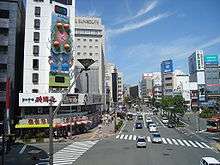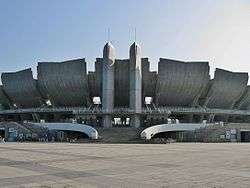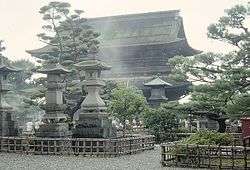Nagano, Nagano
| Nagano 長野市 | ||
|---|---|---|
| Core city | ||
| Nagano City | ||
|
From top of left, Zenkoji, Mount Togakushi, Kinasa village, Nagano Big Hat arena, Airial in Kawanakajima, Oku-Subana Valley, Marukome, which headquarter in Nagano, and famous for miso product company in Japan, Oyaki Japanese sweets, Togakushi ski place, and Matsushiro Castle | ||
| ||
 Location of Nagano in Nagano Prefecture | ||
 Nagano Location in Japan | ||
| Coordinates: 36°38′N 138°11′E / 36.633°N 138.183°ECoordinates: 36°38′N 138°11′E / 36.633°N 138.183°E | ||
| Country | Japan | |
| Region | Chūbu (Kōshin'etsu) | |
| Prefecture | Nagano Prefecture | |
| Government | ||
| • Mayor | Hisao Katō | |
| Area | ||
| • Total | 834.85 km2 (322.34 sq mi) | |
| Population (April 1, 2011[1]) | ||
| • Total | 376,578 | |
| • Density | 450/km2 (1,200/sq mi) | |
| Symbols | ||
| • Tree | Tilia japonica | |
| • Flower | Apple | |
| Time zone | Japan Standard Time (UTC+9) | |
| City hall address |
1613 Midori-chō, Nagano-shi, Nagano-ken 380-8512 | |
| Website |
www | |
Nagano (長野市 Nagano-shi), the capital city of Nagano Prefecture, is located in the northern part of the prefecture near the confluence of the Chikuma and the Sai rivers, on the main Japanese island of Honshū.
As of April 1, 2011, the city had an estimated population of 387,146 and a population density of 460 persons per km². The total area is 834.85 km².
Description
Nagano is most famous for Zenkō-ji, a 7th-century Buddhist temple that overlooks the city. A million tourists visit Nagano annually. Nagano was originally a town in Kamiminochi District built around the hilltop temple that is the largest wooden building in eastern Japan, but the city now encompasses locations that were within Sarashina, Hanishina, and Kamitakai districts.

Geography
Surrounding municipalities
All but the city of Myōkō are within Nagano Prefecture.
- North: Towns of Shinano and Iizuna and city of Myōkō, Niigata Prefecture
- East: Cities of Nakano and Suzaka and town of Obuse
- South: Cities of Ueda and Chikuma
- Southwest: City of Ōmachi and villages of Omi, Chikuhoku and Ikusaka
- West: Village of Ogawa
- Northwest: Villages of Hakuba and Otari
- Northeast: Yamanouchi Area & Village of Yudanaka[2]
History
The city is located within Minuchi (水内郡), Takai (高井), Sarashina (更級郡), and Hanishina (埴科郡) Districts in the ancient Shinano Province. Zenkō-ji relocated from the current city of Iida (642). Afterwards, the town of Monzen became one of the motel towns of Hokkoku Kaidō. The Battles of Kawanakajima were fought there including the fight between Takeda Shingen (武田信玄) and Uesugi Kenshin (上杉謙信). In 1742 (Inu-no-Mansui (戌の満水 or 千曲川大洪水), the water level reached 6.4 metres (21 ft)) at Akanuma (near the border with the former town of Toyono.) Due to Zenko-ji earthquake (May 8, 1847), nearly 10,000 people died. Nagano gained city status in 1897. The Matsushiro Underground Imperial Headquarters (松代大本営) was started in 1944, but was cancelled in 1945 due to the end of war. The city hosted the biggest mergers of the Showa Era I in 1954. In 1959, due to the flooding of Chikuma River, 71 people died or were missing and 20,000 homes were flooded. The biggest mergers of the Showa Era II occurred there in 1966. The Matsushiro Earthquake (松代群発地震) was here. Due to landslides (地附山地すべり災害) in 1985, 27 people died and 60 homes were destroyed or badly damaged. The city hosted the 1998 Winter Olympics and the Paralympics. In 1999, Nagano became a core city. Due to the mergers in the Heisei Era, the city absorbed the municipalities of Toyono, and the village of Togakushi, and Kinasa (from Kamiminochi District), and the village of Ōoka (from Sarashina District). Nagano hosted the 2005 Special Olympics World Winter Games.
Expansion
On April 1, 1897, the city was founded. It became the first city founded in Nagano Prefecture and the 43rd city in Japan. On October 16, 1966, the current and the second city of Nagano was founded by merging with 8 municipalities, including the original city. On January 1, 2005, the city absorbed municipalities from Kamiminochi District (Toyono, Togakushi and Kinasa) and Sarashina District (Ooka). On January 1, 2010, Nagano absorbed the town of Shinshūshinmachi and the village of Nakajō from Kamiminochi District.[3]
Climate
Nagano has a humid subtropical climate (Köppen climate classification Cfa), bordering on humid continental (Köppen Dfa); its location in a sheltered inland valley means it receives less precipitation than any part of Japan except Hokkaidō. The city receives heavy winter snow totaling 2.57 metres (101 in) from December to March, but it is less gloomy during these cold months than the coast from Hagi to Wakkanai.
| Climate data for Nagano, Nagano (1981–2010) | |||||||||||||
|---|---|---|---|---|---|---|---|---|---|---|---|---|---|
| Month | Jan | Feb | Mar | Apr | May | Jun | Jul | Aug | Sep | Oct | Nov | Dec | Year |
| Record high °C (°F) | 18.1 (64.6) |
22.5 (72.5) |
24.4 (75.9) |
30.8 (87.4) |
32.6 (90.7) |
35.6 (96.1) |
37.9 (100.2) |
38.7 (101.7) |
36.3 (97.3) |
32.2 (90) |
26.2 (79.2) |
21.3 (70.3) |
38.7 (101.7) |
| Average high °C (°F) | 3.5 (38.3) |
4.7 (40.5) |
9.5 (49.1) |
17.3 (63.1) |
22.5 (72.5) |
25.7 (78.3) |
29.1 (84.4) |
31.0 (87.8) |
25.6 (78.1) |
19.2 (66.6) |
13.0 (55.4) |
6.8 (44.2) |
17.3 (63.1) |
| Daily mean °C (°F) | −0.6 (30.9) |
0.1 (32.2) |
3.8 (38.8) |
10.6 (51.1) |
16.0 (60.8) |
20.1 (68.2) |
23.8 (74.8) |
25.2 (77.4) |
20.6 (69.1) |
13.9 (57) |
7.5 (45.5) |
2.1 (35.8) |
11.9 (53.4) |
| Average low °C (°F) | −4.1 (24.6) |
−3.8 (25.2) |
−0.8 (30.6) |
4.9 (40.8) |
10.5 (50.9) |
15.8 (60.4) |
20.0 (68) |
21.3 (70.3) |
16.9 (62.4) |
9.7 (49.5) |
3.1 (37.6) |
−1.6 (29.1) |
7.7 (45.9) |
| Record low °C (°F) | −17.0 (1.4) |
−16.4 (2.5) |
−14.6 (5.7) |
−6.5 (20.3) |
−1.8 (28.8) |
3.9 (39) |
10.2 (50.4) |
10.7 (51.3) |
5.5 (41.9) |
−1.9 (28.6) |
−11.4 (11.5) |
−15.2 (4.6) |
−17.0 (1.4) |
| Average precipitation mm (inches) | 51.1 (2.012) |
49.8 (1.961) |
59.4 (2.339) |
53.9 (2.122) |
75.1 (2.957) |
109.2 (4.299) |
134.4 (5.291) |
97.8 (3.85) |
129.4 (5.094) |
82.8 (3.26) |
44.3 (1.744) |
45.5 (1.791) |
932.7 (36.72) |
| Average snowfall cm (inches) | 98 (38.6) |
82 (32.3) |
27 (10.6) |
3 (1.2) |
0 (0) |
0 (0) |
0 (0) |
0 (0) |
0 (0) |
0 (0) |
2 (0.8) |
45 (17.7) |
257 (101.2) |
| Average precipitation days (≥ 0.5 mm) | 13.0 | 11.5 | 12.0 | 9.2 | 10.0 | 11.4 | 13.1 | 9.8 | 11.7 | 9.1 | 8.6 | 10.4 | 129.8 |
| Average snowy days | 22.9 | 19.6 | 8.2 | 0.6 | 0.0 | 0.0 | 0.0 | 0.0 | 0.0 | 0.0 | 0.9 | 10.8 | 63 |
| Average relative humidity (%) | 78 | 74 | 68 | 61 | 64 | 70 | 74 | 72 | 74 | 75 | 76 | 77 | 71.9 |
| Mean monthly sunshine hours | 127.2 | 131.3 | 168.5 | 198.3 | 207.3 | 162.2 | 168.8 | 204.3 | 141.7 | 152.4 | 139.1 | 135.6 | 1,936.7 |
| Source #1: Japan Meteorological Agency[4] | |||||||||||||
| Source #2: Japan Meteorological Agency (records)[5] | |||||||||||||
| Nagano, Nagano (1981–2010) | ||||||||||||||||||||||||||||||||||||||||||||||||||||||||||||
|---|---|---|---|---|---|---|---|---|---|---|---|---|---|---|---|---|---|---|---|---|---|---|---|---|---|---|---|---|---|---|---|---|---|---|---|---|---|---|---|---|---|---|---|---|---|---|---|---|---|---|---|---|---|---|---|---|---|---|---|---|
| Climate chart (explanation) | ||||||||||||||||||||||||||||||||||||||||||||||||||||||||||||
| ||||||||||||||||||||||||||||||||||||||||||||||||||||||||||||
| ||||||||||||||||||||||||||||||||||||||||||||||||||||||||||||
1998 Winter Olympics and Paralympics
Nagano hosted the 1998 Winter Olympics and Paralympics, the third Olympic Games and second winter Olympics to be held in Japan, after the Tokyo 1964 Summer Olympics and the 1972 Winter Olympics in Sapporo (the first Winter Games ever held in Asia). As of 2010, Nagano was the southernmost host of the Winter Olympic Games. The Nagano Olympic Commemorative Marathon is held annually to commemorate the occasion.

Sightseeing


The historic site of the Battles of Kawanakajima was converted into parkland, with a municipal museum of the history of the Zenkoji plain.
Matsushiro, the former castle town of the Sanada clan, is located in the southern part of the city. The town retains an historic atmosphere, preserving many samurai residences, temples, and gardens of the feudal period, including the remains of the castle and mansion of feudal Lord Sanada Jumangoku.
Sporting venues built for the Winter Olympics include the M-Wave speed-skating arena (with the world's largest wooden suspension roof), Big Hat arena, and the Aqua Wing Arena.
North of the city is the village of Iizuna. A popular destination in both summer and winter, it includes a ski resort, campsite, onsen, 10 ponds and a mountain slide ride.
Northeast of the city is Japan's largest ski resort, Shiga Kogen,[6] with the nearby Jigokudani Monkey Park,[7] famous for the wild Japanese macaque often found bathing in its hot springs.
South of the downtown core, in Shinano, Mt. Chausu hosts the Nagano Chausuyama Zoo, an outdoor dinosaur park, botanical garden and museum of natural history.
Transportation
Rail
The city's main railway hub, Nagano Station, and the smaller Shinonoi Station, were expanded for the Olympics. The Hokuriku Shinkansen opened in 1997 (initially named the "Nagano Shinkansen"), connecting Nagano to Takasaki, Gunma. Nagano Station also serves the Shinano Railway Line, Shinetsu Main Line, and Iiyama Line. The JR Chūō Main Line connects Nagano to the major city of Nagoya in Aichi Prefecture.
The Nagano Electric Railway also runs the Nagano Line to major sites around the city and its suburbs.
The city is connected by rail south to Matsumoto via the Shinonoi Line, which terminates at Shinonoi Station.
Bus
Buses for Kawanaka-jima Bus and the Nagano Dentetsu Bus Co. service the city, departing both Nagano Station and the Nagano Bus Terminal just west of the station.
Air
The city's nearest domestic airport is Matsumoto Airport, connected via a 70-minute express bus from Nagano City.
Education
The city has primary, middle and high schools, along with a technology college.
Elementary
Middle
- Imoi Junior High school
- Kotoku Junior High school
- Naniai Junior High School
- Sanyo Junior High School
- Seibu Junior High School
- Shinonoi-Nishi Junior High School
High
- Satsuki High School
- Nagano Nihon University High School
- Nagano Ichiritsu High School
- Nagano Nishi(west) High School
College of Technology
Sports
There is a local football club AC Nagano Parceiro in J3 League.
Sister City
 Clearwater, Florida, United States
Clearwater, Florida, United States
References
- ↑ 市政情報 > 市の沿革・概要 > 人口・面積・自然. Nagano official website (in Japanese). Nagano City. Retrieved May 1, 2015.
- ↑ "Yamanouchi Town". Info-yamanouchi.net. Retrieved 2013-10-04.
- ↑ 長野市・信州新町・中条村合併後調査報告について. Nagano official website (in Japanese). Nagano City. Retrieved 18 September 2011.
- 1 2 "平年値(年・月ごとの値)". Japan Meteorological Agency. Retrieved 2010-10-29.
- ↑ "観測史上1~10位の値(年間を通じての値)". Japan Meteorological Agency. Retrieved 2010-10-29.
- ↑ Snow Monkeys. "Shiga Kogen | Snow Monkeys". Yudanaka-shibuonsen.com. Retrieved 2013-10-04.
- ↑ Snow Monkeys (2012-09-27). "Snow Monkey park | Snow Monkeys". Yudanaka-shibuonsen.com. Retrieved 2013-10-04.
External links
| Wikimedia Commons has media related to Nagano. |
| Wikivoyage has a travel guide for Nagano. |
- Nagano City official website (Japanese)
- Nagano Convention & Visitors Bureau
- Nagano 2005 Special Olympics World Winter Games official website
- Nature, Culture & Technology Issues & Activities around Nagano
